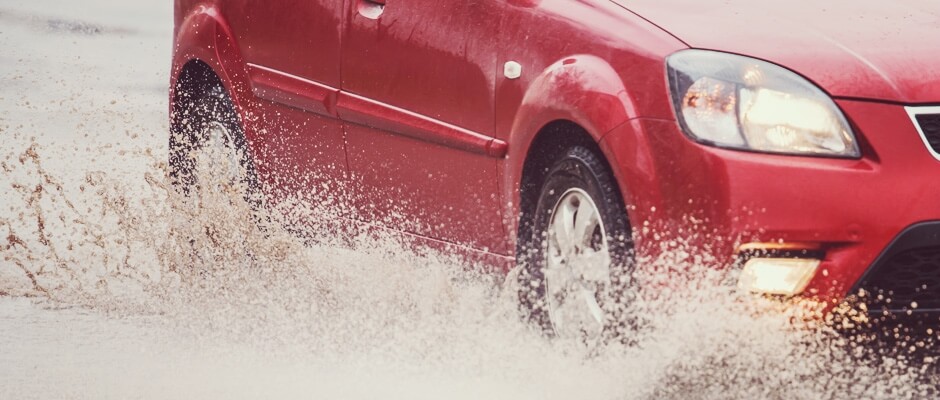It’s more and more common for the UK, and other countries, to be hit by severe storms, causing considerable flooding.
When hit by adverse weather such as floods, the roads can become very dangerous, so it’s important that you know when it’s safe to drive and how to get yourself home safely.
Here, we explain everything you need to know about driving through floods.
Prepare
As with driving in any extreme weather, assess whether it is absolutely essential for you to travel. If you can avoid driving and find another means of transport, this is often a better option. If you must drive, tell a member of your family or a friend, giving them your route and expected arrival time.
Assess
If you can’t tell how deep the water is, you shouldn’t go ahead. In any case, you should avoid driving through floods if they are deeper than 6 inches. Any deeper than this and your car is likely to cut out completely, and the water could cause serious and often irreparable damage to your engine and electrics.
If the water is moving and is deeper than around 4 inches,² do not proceed to drive through the flood. Park in a safe place nearby and try to find an alternative means of getting home. If you continue driving you might lose grip of the road and your car could be dragged along into deeper, more dangerous waters.
Driving through floods
- If you believe the flood water is at a safe height, proceed with utmost care: drive through very slowly in first gear until you are out of the water.³ This will ensure that the exhaust doesn’t flood and that water doesn’t shoot up into your engine bay and damage your electrics. If water enters your car’s air intake this is likely to cause severe damage.
- Try not to stop – allow all oncoming traffic and cars in front to pass, to avoid having to stop in the middle of the flood. Once the road is clear, continue very carefully to keep a single flow of water passing under the car.⁴
- Do not feel pressurised by other drivers; if you are trying to negotiate a flooded road and another vehicle is behaving aggressively behind you, do not feel under pressure to speed up.
Poor road conditions
- Watch out for hidden potholes. If you are driving slowly enough, these should have less of an impact on your car. The cambers (edges) of the road will be the deepest; stay as close to the middle of the road as possible (on your own side, of course).
- If you are driving on a country road, beware of ditches at the side of the road. The water means that it is a lot harder to work out where the road ends and the ditch begins.
Worst case scenario
- Should the worst happen, and water enters your car through the engine or the air intake, and it cuts out, do not start the engine back up again⁵ – instead call for recovery and seek professional examination. Trying to start the car may pull the water further through the car’s system and cause engine failure.
Flooding and your car
- Cars are not designed to be immersed in water. This means that when water enters certain engine components and contaminates the engine fluids, it can be extremely costly to fix.
- Sometimes it will be considered uneconomical to salvage the engine, depending on the car’s value.
- If salt water has entered the mechanics of your car, it is highly unlikely that it will be viable to fix it.
If your car has been badly affected while driving through floods, you should seek the attention of a mechanic as soon as possible. If caught early enough you might be able to save your car from further damage.
If you have an insurethebox policy and you have experienced damage to your car, please contact us immediately on 0333 103 0030.
Sources:
[1] [2] [3] http://www.telegraph.co.uk/motoring/road-safety/10210793/How-to-drive-through-floods.html
[4] http://www.theaa.com/motoring_advice/seasonal/floods-and-wet-weather.html
[5] http://www.rac.co.uk/advice/winter-driving/driving-in-heavy-rain-and-flooding/
